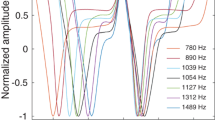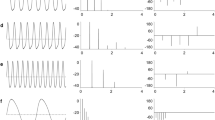Summary
-
1.
A spontaneous EOD response to sound is described in two gymnotoids of the pulseElectricOrganDischarge (EOD) type,Hypopomus andGymnotus, and in one mormyrid,Brienomyrus (Figs. 2–4).
-
2.
In all three species, the EOD response to the sound onset was a transient EOD rate increase. In the low EOD rateHypopomus (3–6 EODs/s at rest) the first, second, or third EOD interval following sound onset was significantly shorter than the average EOD interval before stimulation. The shortest latency found was 100 ms, the longest ca. 1.2 s.Gymnotus (around 50 EODs/s at rest) responded similarly, but the third interval after sound onset was the first to be affected even at highest intensities (shortest latencies approx. 60 ms; latencies > 0.5 s at low sound intensities). InBrienomyrus (4–8 EODs/s at rest) the response occurred already at the first EOD interval after sound onset.
-
3.
An EOD sound response was recorded inHypopomus and inGymnotus up to 5,000 Hz sound frequency (in oneGymnotus individual: up to 7,000 Hz). Due to technical limitations the low frequency limit of the response could not be exactly determined: the fishes responded well even below 100 Hz.Hypopomus had its maximum sensitivity around 500 Hz (Fig. 5),Gymnotus around 1,000 Hz (Fig. 6).
-
4.
In all three species the EOD sound response was graded with sound intensity (Hypopomus: Fig. 7).
-
5.
No EOD response to sound was found in two gymnotoids of the wave type,Eigenmannia andApteronotus, and in the gymnotoid pulse fishRhamphichthys. A criterion is proposed by which it should be possible to predict whether or not a weakly electric fish species will show the EOD sound response.
-
6.
It is concluded that the EOD response to sound is similar to EOD responses to other kinds of stimulation (light, touch, vibration, food, and even electrical). The possible biological function is discussed.
Similar content being viewed by others
References
Banner A (1967) Evidence of sensitivity to acoustic displacements in the lemon shark. In: Cahn P (ed) Lateral line detectors. Indiana University Press, Bloomington, pp 265–273
Bauer R (1974) Electric organ discharge activity of resting and stimulatedGnathonemus petersii (Mormyridae). Behaviour 50:306–323
Black-Cleworth P (1970) The role of electrical discharges in the non-reproductive social behavior ofGymnotus carapo L. (Gymnotidae, Pisces). Anim Behav Monogr 3:1–77
Boutteville K von (1935) Untersuchungen über den Gehörsinn bei Characiniden und Gymnotiden und den Bau ihres Labyrinthes. Z Vergl Physiol 22:162–191
Buerkle U (1968) Relations of pure tone thresholds to background noise level in the Atlantic codGadus morhua. J Fish Res Board Can 25:1150–1160
Diesselhorst G (1938) Hörversuche an Fischen ohne Weberschen Apparat. Z Vergl Physiol 25:748–783
Frisch K von (1936) Über den Gehörsinn der Fische. Biol Rev 11:210–246
Frisch K von (1938) The sense of hearing in fish. Nature 141:8–11
Grözinger B (1967) Elektro-physiologische Untersuchungen an der Hörbahn der Schleie (Tinca tinca (L.). Z Vergl Physiol 57:44–76
Hagiwara S, Morita H (1963) Coding mechanisms of electroreceptor fibers in some electric fish. J Neurophysiol 25:430–449
Hawkins AD (1973) The sensitivity of fish to sounds. Oceanogr Mar Biol Annu Rev 11:291–340
Hawkins AD, Chapman CJ (1975) Masked auditory thresholds in the cod,Gadus morhua L. J Comp Physiol 103:209–226
Hawkins AD, MacLennan DN (1976) An acoustic tank for hearing studies on fish. In: Schuijf A, Hawkins AD (eds) Sound reception in fish. Elsevier, Amsterdam Oxford New York, pp 149–169
Heiligenberg WF (1977) Principles of electrolocation and jamming avoidance in electric fish. Studies of brain function, vol 1. Springer, Berlin Heidelberg New York, pp 1–85
Jäger U (1974) Geruchsrezeption und Entladungsaktivität bei dem schwachelektrischen FischGnathonemus petersii (Günther 1862) (Mormyridae, Teleostei). Diss Math-Nat Fak Univ Saarland, Saarbrücken (FRG)
Kramer B (1976) The attack frequency ofGnathonemus petersii towards electrically silent (denervated) and intact conspecifics, and towards another mormyrid (Brienomyrus niger). Behav Ecol Sociobiol 1:425–446
Kramer B, Kirschbaum F, Markl H (1981) Species specificity of electric organ discharges in a sympatric group of gymnotoid fish from Manaus (Amazonas). In: Szabo T, Czéh G (eds) Sensory physiology of lower aquatic vertebrates. Adv Physiol Sci, vol 31. Pergamon Press/Akademiai Kiadó, Budapest, pp 195–219
Lissmann HW (1958) On the function and evolution of electric organs in fish. J Exp Biol 35:156–191
Lissmann HW (1961) Ecological studies on gymnotids. In: Chagas C, Paes de Carvalho A (eds) Bioelectrogenesis. Elsevier, Amsterdam Oxford New York, pp 215–226
Markl H, Ehret G (1973) Die Hörschwelle der Maus (Mus musculus). Eine kritische Wertung der Methoden zur Bestimmung der Hörschwelle eines Säugetieres. Z Tierpsychol 33:274–286
Piddington RW (1972) Auditory discrimination between compressions and rarefactions by goldfish. J Exp Biol 56:403–419
Popper AN, Fay RR (1973) Sound detection and processing by teleost fishes: a critical review. J Acoust Soc Am 53:1515–1529
Réthelyi M, Szabo T (1973) A particular nucleus in the mesencephalon of a weakly electric fish,Gymnotus carapo (Gymnotidae). 1. Light microscopic structure. Exp Brain Res 17:229–241
Rigley L, Marshall JA (1973) Sound production by the elephant nose fish,Gnathonemus petersii (Pisces, Mormyridae). Copeia 1973(1):134–136
Schade R (1971) Experimentelle Untersuchungen zum Hörvermögen anLeucaspius delineatus. Biol Zentralbl 90:337–356
Scheich H, Gottschalk B, Nickel B (1977) The jamming avoidance response inRhamphichthys rostratus: An alternative principle of time domain analysis in electric fish. Exp Brain Res 28:229–233
Schlegel PA (1977) Electroreceptive single units in the mesencephalic magnocellular nucleus of the weakly electric fishGymnotus carapo. Exp Brain Res 29:201–218
Schwartzkopff J (1976) Comparative-physiological problems of hearing in fish. In: Schuijf A, Hawkins AD (eds) Sound reception in fish. Elsevier, Amsterdam Oxford New York, pp 3–17
Stipetić E (1939) Über das Gehörorgan der Mormyriden. Z Vergl Physiol 26:740–752
Szabo T (1967) Activity of peripheral and central neurons involved in electroreception. In: Cahn P (ed) Lateral line detectors. Univ Indiana Press, Bloomington, pp 295–311
Tautz J (1979) Reception of particle oscillation in a medium — an unorthodox sensory capacity. Naturwissenschaften 66:452–461
Tavolga WN (1967) Masked auditory thresholds in teleost fishes. In: Tavolga WN (ed) Marine bio-acoustics, vol 2. Pergamon Press, Oxford New York, pp 233–245
Tavolga WN (1971) Sound production and detection. In: Hoar WS, Randall DJ (eds) Fish physiology, vol 5. Academic Press, New York, pp 135–205
Tavolga WN (1976) Recent advances in the study of fish audition. In: Tavolga WN (ed) Sound reception in fishes. Benchmark papers in animal behavior, vol 7. Dowden, Hutchinson and Ross, Stroudsberg, Philadelphia, pp 37–52
Veit I (1977) Ein kleines Druckgradientenhydrofon zur Messung der Schallschnelle in Flüssigkeiten. Akustika 38:72–75
Westby GWM (1975) Has the latency-dependent response ofGymnotus carapo to discharge-triggered stimuli a bearing on electric fish communication? J Comp Physiol 96:307–341
Author information
Authors and Affiliations
Additional information
We wish to thank Dr. J. Kien (University of Regensburg), Dr. F. Kirschbaum (University of Köln), and Dr. G.W.M. Westby (University of Sheffield) for critically reading the manuscript. This work was supported by the Deutsche Forschungsgemeinschaft (grants Kr 446/8, Ma 374/10). We wish to thank the computer centre and the mechanical, the electronical, and the carpentry workshop of the University of Konstanz for excellent aid. It is a pleasure to acknowledge the expert technical assistance of H.-J. Burger.
Rights and permissions
About this article
Cite this article
Kramer, B., Tautz, J. & Markl, H. The EOD sound response in weakly electric fish. J. Comp. Physiol. 143, 435–441 (1981). https://doi.org/10.1007/BF00609910
Accepted:
Issue Date:
DOI: https://doi.org/10.1007/BF00609910




